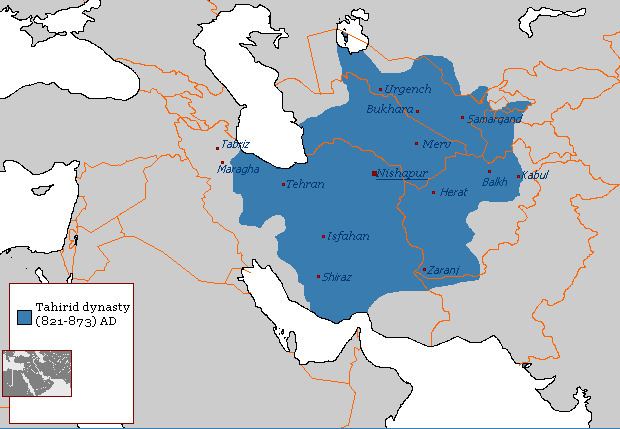Name Muhammad Tahir | Died 890 AD | |
 | ||
Abu 'Abdallah Muhammad ibn Tahir ibn 'Abdallah (Arabic: أبو عبد الله محمد بن طاهر بن عبد الله, died c. 910) was the last Tahirid governor of Khurasan, from 862 until 873.
Contents
Governor of Khurasan
When Muhammad's father Tahir ibn Abdallah died in 862, the caliph wanted to replace him with Tahir's brother Muhammad ibn Abdallah ibn Tahir, but after the latter refused he appointed Muhammad as governor. The caliph however did not grant Muhammad other titles usually reserved for the Tahirid governor of Khurasan, such as the military governorship of Iraq and Baghdad (sahib al-shurta), but instead gave them to Muhammad ibn Abdallah.
When he became governor, Muhammad was still young and rather inexperienced. Only two years after he succeeded his father, Tabaristan was lost to a Zaydi revolt under Hasan ibn Zayd ibn Muhammad, and the Tahirids were unable to recover the province. In 867 the Saffarid amir of Sistan, Ya'qub al-Saffar, took Herat and imprisoned its Tahirid governor. An army was dispatched under the Samanid Ibrahim ibn Ilyas to stop Ya'qub, but was defeated, after which Muhammad was forced to come to terms. During this time Muhammad also tried to gain the offices in the West that had been given to his uncle Muhammad. After the latter died in 867 his brother 'Ubaydallah had taken over the offices. In opposition to Ubaydallah, Muhammad sent another uncle, Sulayman ibn 'Abdallah, as his representative in Iraq, and Sulayman was able to gain the posts at the expense of Ubaydallah, although the latter would eventually recover them.
The weakness of Muhammad's rule in Khurasan would eventually lead to the end of Tahirid rule there. In 873 the Saffarid Ya'qub marched on Muhammad's capital, Nishapur. Muhammad refused to flee and was captured by the Saffarids. For three years he remained in captivity, but was freed by caliphal forces after the Saffarids were defeated at the Battle of Dair al-'Aqul in 876. After he was freed the caliph reinvested him with the governorship of Khurasan, although Muhammad never asserted his authority there. Several anti-Saffarid partisans in Khurasan, such as Ahmad al-Khujistani and Rafi' ibn Harthama, placed Muhammad's name in the khutba in areas they managed to control, but Muhammad never exercised any actual authority over them.
Later life
After being freed by the caliph Muhammad took up residence in Baghdad and from there attempted to gain the offices held by Ubaydallah ibn Abdallah. This conflict between the two Tahirids would continue for several years. In 879 the Saffarid Ya'qub died and was succeeded by his brother Amr bin Laith. Amr reached an agreement with the caliph and was invested with Khurasan, replacing Muhammad. As the governor of Khurasan, Amr now asserted the rights formally held by the Tahirids to nominate his representative for the offices in the West; his choice fell on 'Ubadydallah. Amr also used his influence to have Muhammad arrested for allegedly supporting Khujistani, although there was little evidence to support this.
Muhammad regained caliphal favor when the peace between the caliphate and the Saffarids fell out in around 884. He was made governor of Baghdad in place of 'Ubaydallah and regained the title of governor of Khurasan, though as before he was never able to reestablish his rule in that province. He died sometime around 910.
